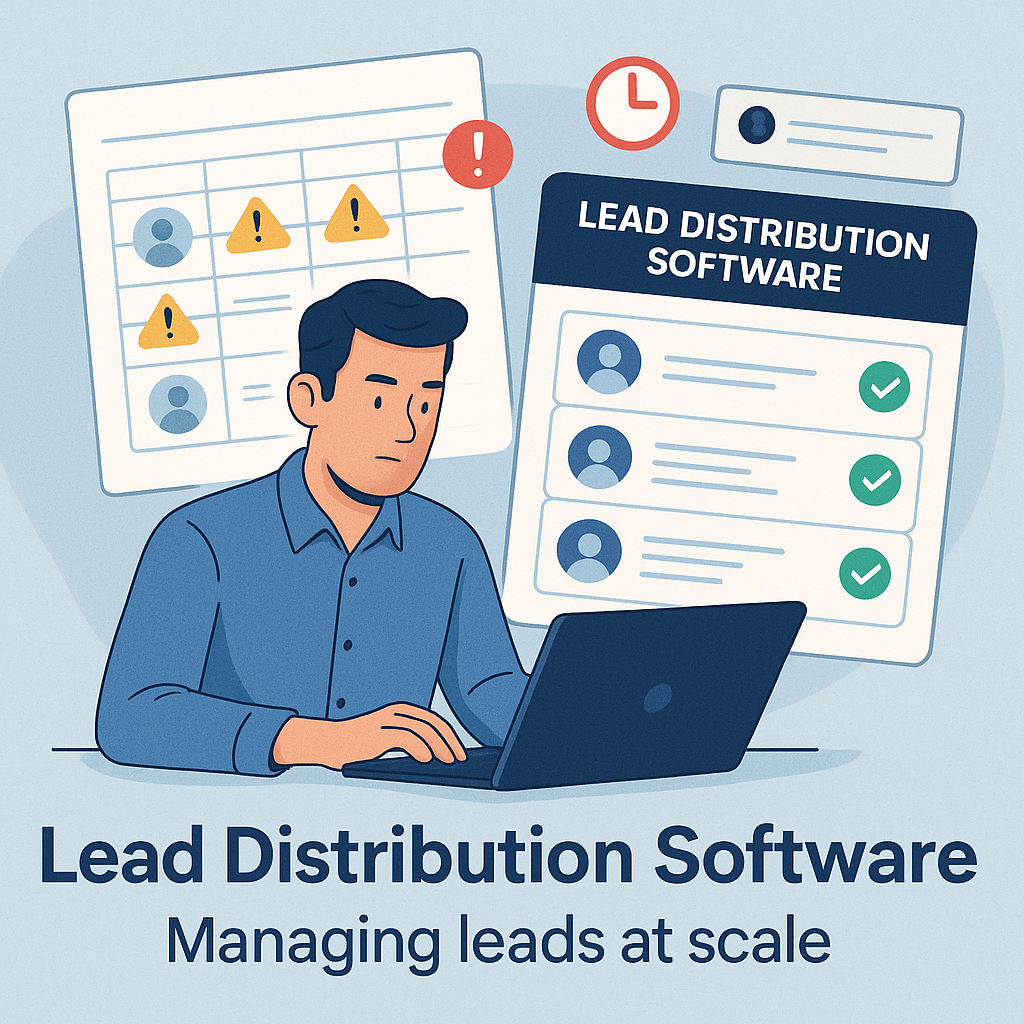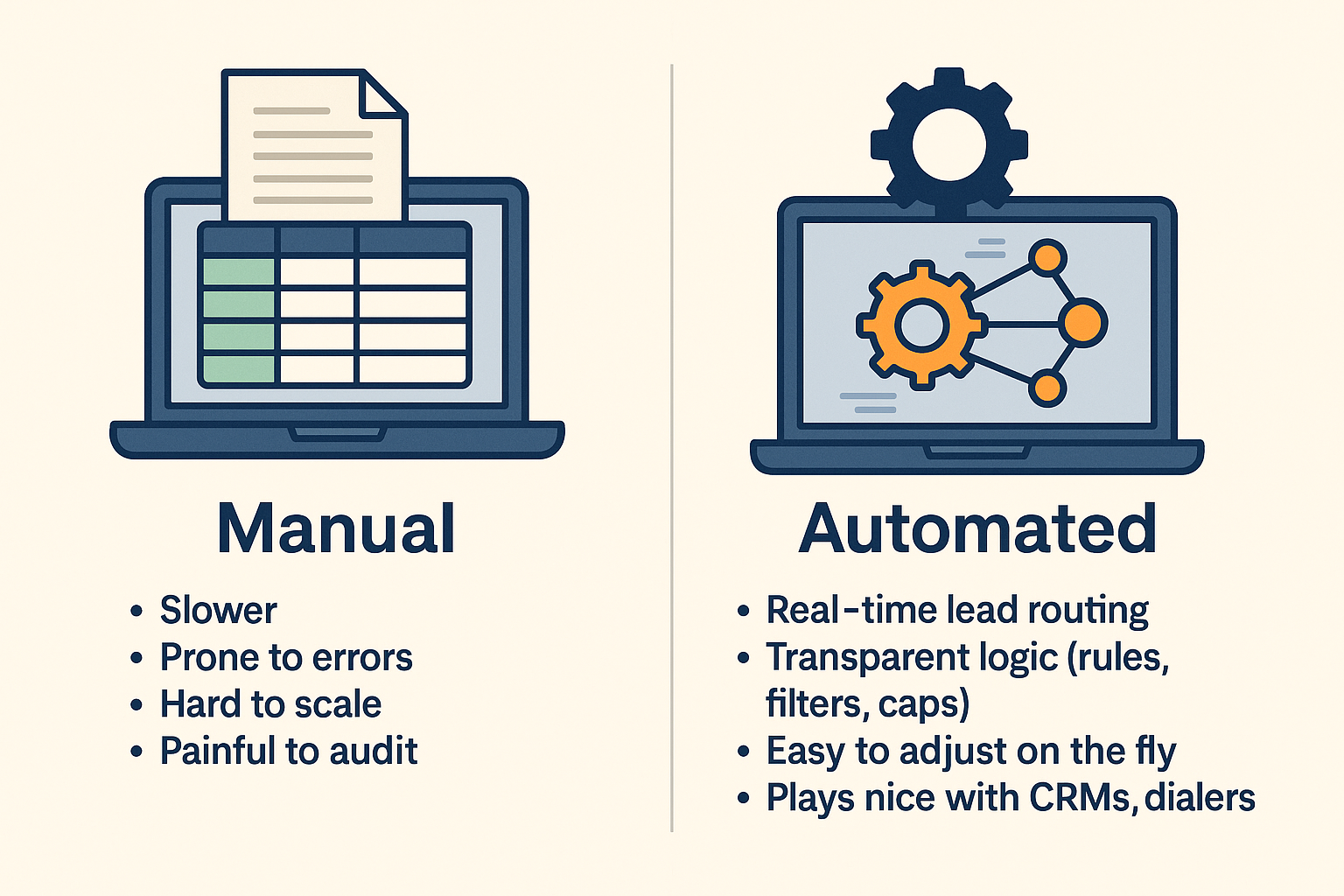Let’s face it: Handling lots of leads can be a total mess if you don't have a good system.
One minute, you're trying to keep track of everything in spreadsheets and sending leads to buyers on your own.
The next, you’re getting complaints like, “This lead is a duplicate!”, “This doesn’t fit our criteria,” or “We didn’t get the info fast enough.” Sound familiar?
That’s where lead distribution software comes in handy, it can really change things. But not every platform is made equal, so picking the right one for what you need in 2025 can be tricky.
So, let’s see what this software does and how to pick one that grows with you, instead of making things harder.

🚦What Is Lead Distribution Software?
Simply put, lead distribution software is a system that sends leads to the correct buyers, reps, or other systems — right away.
Think of it as a traffic controller for your sales process:
📍 If the lead is in Florida? Send it to Buyer A.
📍 Is it after working hours? Send it to an answering service.
📍 Is it a duplicate? Don’t send it anywhere.
It swaps old ways of doing things with a system that does it for you, so your leads always end up where they should, following the guidelines you set.

🤔 Who Uses It (and Why It’s Critical)
If you're doing performance marketing, affiliate management, or getting leads, you need this.
- Lead sellers use it to earn as much as possible by selling to many buyers.
- Agencies/networks use it to manage lead quality and partner payments.
- Call centers use it to send incoming calls or form submissions to available agents.
- Big sales teams use it to give leads to the right salesperson or CRM based on different factors.
If you're dealing with more than 20 leads daily, lead distribution software is a must-have.
🛠️ Manual Routing vs Automated Distribution
You could try to handle everything yourself using spreadsheets, Google Forms, and hoping for the best… but please don’t.
Manual:
- Slower
- Easy to make mistakes
- Tough to grow
- Hard to check
Automated:
- Sends leads in real time
- Clear rules
- Easy to change
- Works well with CRMs and other tools
The benefit of a system isn’t just saving time, but also not wasting leads and buyers getting annoyed.

📊 What to Look for in a Scalable Platform
If you’re checking out lead distribution platforms, here are the things that really matter:
✅ 1. Real-Time Ping Post Support
You want leads sent fast. Platforms like Standard Information have ping post — a 2-step thing where buyers see leads and offer bids before getting them.
Why is this important? You get a better buyer match, fewer leads returned, and prices that change with the market.
✅ 2. Advanced Filtering and Validation
- Block duplicate leads
- Filter by time, location, and type
- Check for TCPA compliance
- Work with tools that check phone/email info
No buyer wants to pay for leads that are fake, old, or don’t follow the rules. Good filters keep everyone happy.
✅ 3. Multi-Buyer Routing / Ping Trees
You should be able to set up buyer waterfalls, so if Buyer A doesn’t want the lead, it goes to Buyer B.
✅ 4. No-Code or Low-Code Configuration
You’ll want:
- Reports for each campaign
- Tracking to see if anything came of it
- Error tracking (Why didn’t this lead get sent?)
- Bid data
The goal is to see what’s happening and change things as needed.
✅ 5. Dashboards for Buyers and Campaigns
CRMs, form tools, fraud checks — your lead software needs to connect to all of them.
Platforms like Standard Information have pre-built connections and an API. No jury-rigging needed.
✅ 6. Integrations and API Access
CRMs, dialers, form tools, fraud checks — your lead software needs to talk to them all.
Platforms like Standard Information include pre-built integrations and a full API if needed. No duct tape required.
🧠 Pro Tip: Don’t Ignore Compliance
Lead compliance isn’t just a box to check, it’s really important. Your platform should:
- Enforce TCPA/FCC rules
- Check against do-not-call lists
- Keep records of consent
- Track how leads agreed to be contacted
If you’re dealing with sensitive info (insurance, health, debt), this is a must.
🔄 Common Pitfalls to Avoid
Here’s where people mess up:
🚫 Picking a CRM that tries to route leads, but doesn’t do it well
🚫 Relying on just one buyer
🚫 Ignoring fraud and data safety
🧩 How Standard Information Fits
If you're checking out lead distribution software, we’ve built Standard Information for lead sellers who want:
- Ping post + direct post
- AI for onboarding and routing
- Easy-to-use rules
- Appointment setting
- Compliance support
It’s all made to handle anything from 50 leads/day to 50,000.

📌 Final Thoughts
Lead distribution is about matching the right lead to the right buyer, at the right time, following the correct guidelines.
The right software saves you time, gets you more money, makes buyers happier, and helps you stay compliant. That’s worth doing right.
FAQs
Q: What is lead distribution software? Lead distribution software automates the process of routing leads to buyers or reps based on rules like geography, time, and quality.
Q: How is it different from a CRM? CRMs manage customer relationships after the lead is received. Lead distribution software handles routing before a lead is accepted.
Q: What features should I look for? Ping post support, real-time routing, filtering, no-code tools, fraud prevention, and buyer dashboards.